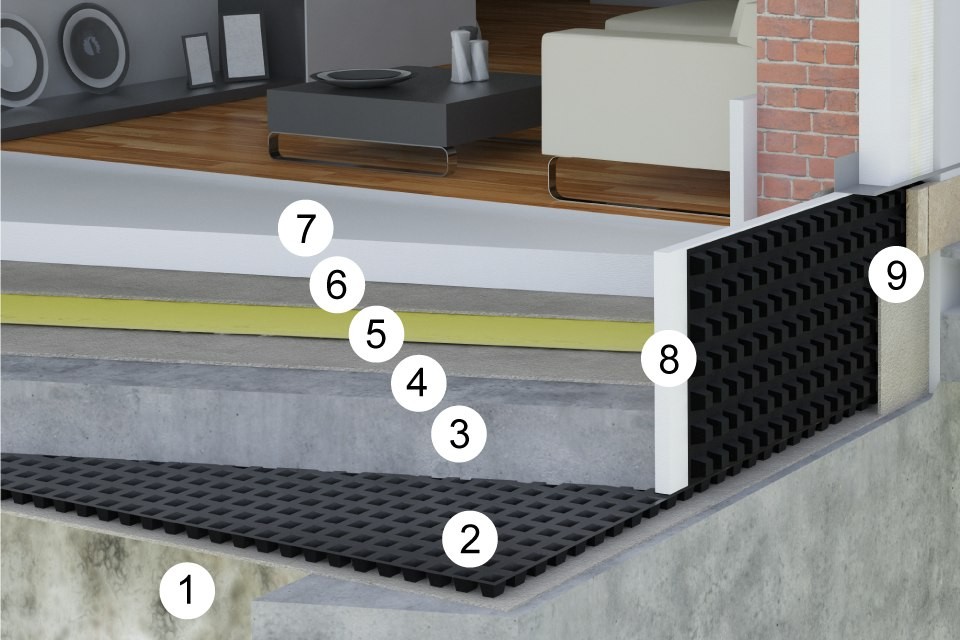

Radioactive gas radon occurs freely in the subsoil. The Czech Republic belongs to the countries with its highest concentration in the world. However, you do not have to worry. High quality insulation minimizes the harmful effects of radon.
Insufficient foundation insulation, cracked flooring or poorly sealed perforations of utility networks are inappropriate. The temperature difference between the subsoil and the interior will cause the chimney effect, and the under-pressure sucks the harmful radon into the house. Its inhalation causes internal lung irradiation and in some cases leads to a cancer.
According to Art. 6, Paragraph 4 in Act No. 18/1997 Coll. on Peaceful Utilization of Nuclear Energy and Ionizing Radiation everybody who designs location of building with residential rooms is obliged to provide a measurement of radon index in the building plot. The results must be submitted to Construction Administration.
Correct insulation against radon is based on the standard ČSN 73 0601 Protection of houses against radon from the soil. All PENEFOL® foils meet the requirements of the respective standard. Simply select the appropriate film thickness based on the measurement data.
| Membrane | Material | Coefficient of radon diffusion D [10-12m2/s] | Diffusion length l [mm] |
| PENEFOL® 750 | LDPE | 13,0 (+/- 1) | 2,488 |
| PENEFOL® 800 | LDPE | 8,6 (+/- 0,5) | 2,024 |
| PENEFOL® 950 | HDPE | 4,8 (+/- 0,5) | 1,512 |
The advantage is that insulation against radon also serves as waterproofing of the house. Only in cases where a very high radon index is measured on the site, it is necessary to ensure the ventilation under radon insulation. It is recommended to use a studded membrane to ensure the different types of ventilation. This simple measure will greatly increase the safety of the radon barrier.
The LITHOPLAST® INSTAL 20/0.8 studded membrane creates an air gap that takes radon out of the house. An open air gap creates the possibility of transverse radon venting by differential air pressure. Do not forget to put a sufficient layer of thermal insulation over the radial insulation to prevent the house from getting cold because of cold air, especially in winter.
The LITHOPLAST® INSTAL studded membrane cannot be used against radon, if it were located below ground water or in places where rainwater accumulates. For this reason the ventilation must be supplemented with drainage perforated piping with drainage of collected water.

1. The base is a compacted base of gravel.
2. The LITHOPLAST® INSTAL 20/0.8 foil is then placed (loosely). A double-sided adhesive butyl rubber tape of 15 mm with the overlap of 1 row of nods is placed into the joint. Move the foil smoothly to the vertical wall so that you do not interrupt the ventilation gap. The LITHOPLAST® INSTAL is placed to the foundations. The foil projections together with the enclosed geotextile and the PetexDren mesh create a ventilation and drainage layer.
3. Another layer is an underlayer concrete screed (at least 80 mm), which is reinforced with a 100/100/5.0 steel concrete net.
4. IZOLTECH H 300 underlayer geotextile with the overlap of 50mm is placed freely in the following step.
5. Compactly welded anti-radon insulation PENEFOL® 750 or PENEFOL® 800 with gastight details is the next step.
6. IZOLTECH H 300 geotextile with overlap of 50mm placed freely protects the insulation. We will use it twice in the whole construction.
7. Apply heat insulation and other floor layers onto it.
8. Now we return to the perimeter section. As a next step, place the thermal insulation of the perimeter.
9. The last thing is lining the plinth with a supporting exterior slab.